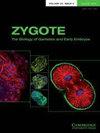Development of a PCR-based method to identify fetal sex during IVF cycles
IF 1.4
4区 生物学
Q4 CELL BIOLOGY
引用次数: 0
Abstract
One of the most recognizable cases of preimplantation genetic diagnosis (PGD) is X-linked diseases. Diagnosis of fetal sex is essential for couples who are known to be at risk of some X-linked disorders. The objective of this study was to discriminate between female (XX) and male (XY) embryos by detecting sex chromosomes-specific sequences in spent culture medium and comparing these results to PGD/CGH array results. It may open new window for the development of a non-invasive PGD method. 120 Embryo’s spent media from Day 3 and Day 5 embryos were collected. Modified phenol-chloroform solution was used for DNA extraction from spent media. Sex determination was performed using SRY, TSPY and AMELOGENIN evaluation through quantitative polymerase chain reaction (q-PCR) method. IBM SPSS and MedCalc were used for statistical analyses to compare sex determination of embryos by spent medium with PGD/CGH array results. Culture time was demonstrated to increase the DNA amount among day 5 embryos culture medium samples. Non-invasive PGD by means of spent culture medium gave a sensitivity, specificity, positive predictive value and negative predictive value of 100% for sex determination. Results of sex determination using spent medium by q-PCR were consistent with the results of PGD/CGH array. Improvements in cell-free DNA extraction and PCR amplification procedures provide us an effective method to perform a PGD test without biopsy in the future, especially about X-linked diseases.在试管婴儿周期中开发基于 PCR 的胎儿性别鉴定方法
植入前遗传学诊断(PGD)最常见的病例之一是 X 连锁疾病。诊断胎儿性别对于已知可能罹患某些X连锁疾病的夫妇来说至关重要。本研究的目的是通过检测废培养基中性染色体的特定序列来区分雌性(XX)和雄性(XY)胚胎,并将这些结果与 PGD/CGH 阵列结果进行比较。这为开发无创 PGD 方法打开了一扇新窗口。从第 3 天和第 5 天的胚胎中收集 120 个胚胎的废培养基。使用改良的苯酚-氯仿溶液从废培养基中提取 DNA。通过定量聚合酶链反应(q-PCR)方法,使用 SRY、TSPY 和 AMELOGENIN 评估进行性别鉴定。使用 IBM SPSS 和 MedCalc 进行统计分析,比较废培养基胚胎性别鉴定结果与 PGD/CGH 阵列结果。结果表明,培养时间会增加第 5 天胚胎培养基样本中的 DNA 数量。用废培养基进行无创 PGD 性别鉴定的灵敏度、特异性、阳性预测值和阴性预测值均为 100%。利用废培养基进行 q-PCR 性别鉴定的结果与 PGD/CGH 阵列的结果一致。无细胞DNA提取和PCR扩增程序的改进为我们提供了一种有效的方法,使我们今后无需活检即可进行PGD检测,尤其是针对X连锁疾病。
本文章由计算机程序翻译,如有差异,请以英文原文为准。
求助全文
约1分钟内获得全文
求助全文
来源期刊

Zygote
生物-发育生物学
CiteScore
1.70
自引率
5.90%
发文量
117
审稿时长
6-12 weeks
期刊介绍:
An international journal dedicated to the rapid publication of original research in early embryology, Zygote covers interdisciplinary studies on gametogenesis through fertilization to gastrulation in animals and humans. The scope has been expanded to include clinical papers, molecular and developmental genetics. The editors will favour work describing fundamental processes in the cellular and molecular mechanisms of animal development, and, in particular, the identification of unifying principles in biology. Nonetheless, new technologies, review articles, debates and letters will become a prominent feature.
 求助内容:
求助内容: 应助结果提醒方式:
应助结果提醒方式:


